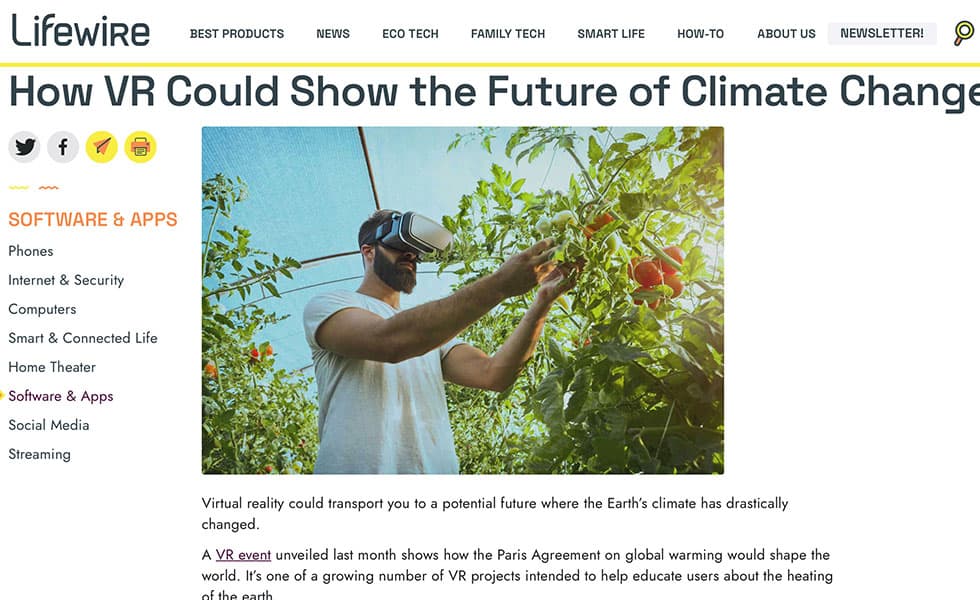How VR Could Show the Future of Climate Change
Originally appeared on Lifewire.com on June 21, 2021 – https://www.lifewire.com/how-vr-could-show-the-future-of-climate-change-5189623
 Virtual reality could transport you to a potential future where the Earth’s climate has drastically changed.
Virtual reality could transport you to a potential future where the Earth’s climate has drastically changed.
A VR event unveiled last month shows how the Paris Agreement on global warming would shape the world. It’s one of a growing number of VR projects intended to help educate users about the heating of the earth.
“Due to its immersive nature, VR is an excellent technological medium to viscerally experience the effects of climate change and drive home the importance of making changes now that will affect the future in positive ways,” Kathleen Ruiz, a professor at Rensselaer Polytechnic Institute who creates VR climate change environments, said in an email interview.
Seeing the Future?
Visitors to the Future Of Everything Festival in May were able to immerse themselves in The Field, a virtual space that explored the impact of the COVID-19 pandemic on the global environmental crisis.
“This is a big year for the climate and wellness,” Robin Wood Sailer, one of the event’s organizers, said in a news release. “The US has reentered the Paris Agreement, President Biden just hosted his Climate Summit, COP26 will be held in Glasgow later this year. Both business and government are coming together to make their sustainability commitments.”
VR experiences also are looking at how climate change could affect specific areas. Scientists at Penn State are building a VR forest that lets people walk through a simulated forest of today and see what various futures may hold for the trees.
“The main problem that needs to be addressed is that climate change is abstract,” Alexander Klippel, a Penn State geography professor, said in a news release. “Its meaning only unfolds in 10, 15, or 100 years. It is very hard for people to understand and plan and make decisions.”
Klippel’s team combined information on forest composition with data on forest ecology to create a forest similar to those found in Wisconsin. The virtual experience takes climate change models, vegetation models, and ecological models and creates a forest set in 2050 that people can experience by walking through it, investigating the tree types, and seeing the changes.
“Due to its immersive nature, VR is an excellent technological medium to viscerally experience the effects of climate change.”
“Rather than being overwhelmed, people are more activated for needed environmental change,” Ruiz said. “The result is that people have a clearer understanding of the many complexities to climate change and can see openings to how simple human behaviors and policies can make a big difference.”
Feel the Heat
New tech could make eco VR experiences even more immersive. View Glass is a technology company that creates “smart glass” that can change the opacity to reduce sunlight, glare, and heat. Developer Groove Jones made a VR experience for View Glass customers connected to a wall of headlamps. When the sun rises in the VR experience, the user sees the sunrise and feels the heat on their skin.
“When the sun was in the high noon position, they would feel the heat rise in intensity,” Dan Ferguson, co-founder of Groove Jones, said in an email interview.
“When the sun was in the high noon position, they would feel the heat rise in intensity,” Dan Ferguson, co-founder of Groove Jones, said in an email interview. “When the user changed the opacity of the glass, the glare was reduced, along with the intensity of the heat.”

Groove Jones also created tools to let users select different environments and weather scenarios. The software connects to a heat wall, activated when the user makes selections in their VR environment. You also can turn a dial to control the angle and position of the sun, which activates headlamps in their actual location to simulate what you are seeing and controlling. “Being able to see climate change and physically feel temperature change is powerful,” Ferguson said.

